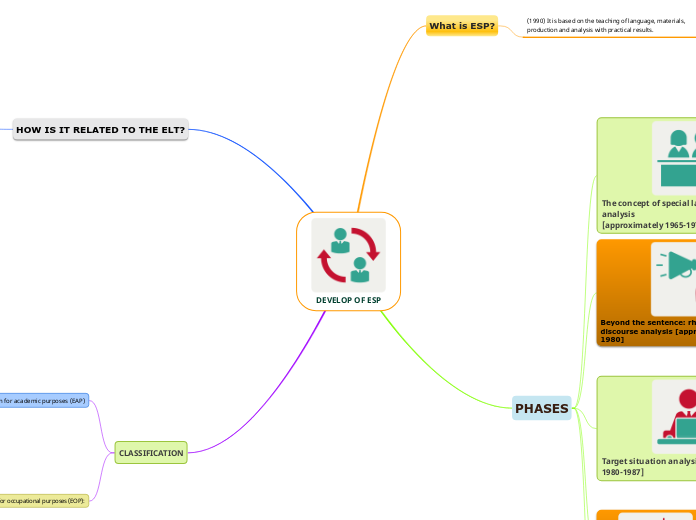
DEVELOP OF ESP
What is ESP?
(1990) It is based on the teaching of language, materials, production and analysis with practical results.
PHASES
![The concept of special language: register analysis
[approximately 1965-1974]](https://www.mindomo.com/pictures/thumbnails/gallery/edu/edu-bench.png)
The concept of special language: register analysis
[approximately 1965-1974]
focussed on language at the sentence level
Identify the grammatical and lexical features of these registers
![Beyond the sentence: rhetorical or discourse analysis [approximately 1974-1980]](https://www.mindomo.com/pictures/thumbnails/gallery/business/announcement.png)
Beyond the sentence: rhetorical or discourse analysis [approximately 1974-1980]
shifted attention to the level above the sentence
Allen and Widdowson (1974)
Hipothesis: We take the view that the difficulties which the students encounter arise not so much from a defective knowledge of the system of English, but from an unfamiliarity with English use, and that consequently their needs cannot be met by a course which simply provides further practice in the composition of sentences, but only by one which develops a knowledge of how sentences are used in the performance of different communicative acts.'
![Target situation analysis [approximately 1980-1987]](https://www.mindomo.com/pictures/thumbnails/gallery/edu/edu-technology-1.png)
Target situation analysis [approximately 1980-1987]
It is based a accurate description of the process concerned
learners' needs
-communication purposes
-communicative setting
-the means of communication
- language skills
- functions, structures

![Skills and strategies [1980]](https://www.mindomo.com/pictures/thumbnails/gallery/business/idea.png)
Skills and strategies [1980]
It is focused in the thinking processes that underlie language use
The focus should rather be on the underlying interpretive strategies
![A learning-centred approach [1987-]](https://www.mindomo.com/pictures/thumbnails/gallery/business/mechanism-5.png)
A learning-centred approach [1987-]
Hutchinson and Waters' (1987)
New approach to ESP. It is based in the methodology, of learning processes, rather than the linguistic basis.
HOW IS IT RELATED TO THE ELT?

ESP focuses on the needs-related nature of instruction and ELT is focused on analyzing needs and preparing students to communicate effectively.
CLASSIFICATION
English for academic purposes (EAP)

It relates to the English needed in an educational context.
English for occupational purposes (EOP):

It relates to professional purposes, e.g. those of working doctors, engineers or business people.
